Are Harmonic Drives Backdrivable? Understanding the Mechanism and Its Implications
Are Harmonic Drives Backdrivable
Harmonic drives are a type of gear system known for their high precision, compact size, and impressive torque capacity. Widely used in robotics, aerospace, and industrial automation, these drives offer exceptional accuracy and repeatability. However, a common question that arises is whether harmonic drives are backdrivable.
Backdrivability refers to the ability of a gear system to be driven in reverse—meaning the output shaft can drive the input shaft. In the case of harmonic drives, backdrivability is generally limited, and this is due to the unique way these drives function.
Harmonic drives operate using a flexible spline, a wave generator, and a rigid circular spline. The wave generator deforms the flexible spline, which then engages with the circular spline to create motion. This design allows for a high reduction ratio in a very compact space, making harmonic drives ideal for applications where space is limited, and precision is critical.
However, the very features that make harmonic drives so precise also make them difficult to backdrive. The high reduction ratios and the friction within the drive components contribute to resistance when attempting to drive the output shaft in reverse. This characteristic can be advantageous in applications where holding torque is important, as it prevents unwanted movement when the system is not powered.
While harmonic drives are not typically backdrivable, there are some exceptions depending on the specific design and application. In certain cases, where lower reduction ratios or modifications are used, some degree of backdrivability can be achieved. However, this is not the norm, and engineers typically choose harmonic drives for their precision and torque capacity rather than for backdrivability.
In conclusion, harmonic drives are generally not backdrivable due to their high reduction ratios and internal friction. This characteristic, while limiting in some contexts, is often a desirable feature in precision applications where stability and accuracy are paramount. Understanding this aspect of harmonic drives is crucial when selecting the right gear system for your specific needs.
 English
English Español
Español Português
Português русский
русский français
français 日本語
日本語 Deutsch
Deutsch Tiếng Việt
Tiếng Việt Italiano
Italiano Nederlands
Nederlands ไทย
ไทย Polski
Polski 한국어
한국어 Svenska
Svenska magyar
magyar Malay
Malay বাংলা
বাংলা Dansk
Dansk Suomi
Suomi हिन्दी
हिन्दी Pilipino
Pilipino Türk
Türk Gaeilge
Gaeilge عربى
عربى Indonesia
Indonesia norsk
norsk اردو
اردو čeština
čeština Ελληνικά
Ελληνικά Українська
Українська Javanese
Javanese فارسی
فارسی தமிழ்
தமிழ் తెలుగు
తెలుగు नेपाली
नेपाली Burmese
Burmese български
български ລາວ
ລາວ Latine
Latine Қазақ
Қазақ Euskal
Euskal Azərbaycan
Azərbaycan slovenský
slovenský Македонски
Македонски Lietuvos
Lietuvos Eesti Keel
Eesti Keel Română
Română Slovenski
Slovenski मराठी
मराठी Српски
Српски
High-Precision Applications of Harmonic Drive Harmonic Gear Reducers in Semiconductor Polishing Equipment
In the front-end processes of semiconductor manufacturing, chemical mechanical planarization (CMP) polishing equipment places extremely stringent requirements on the precision and reliability of transmission components.
Read MoreAnalysis of Harmonic Drive Harmonic Drive Gearboxes' Global Market Application in Laser Processing Centers
In the field of laser processing equipment, high-precision transmission systems are a core element ensuring processing quality. Harmonic Drive harmonic drive gearboxes, with their unique technological advantages, have become a key component of transmission systems in laser processing centers worldwide.
Read MoreHarmonic Drive Harmonic Drive Gearboxes: Global Market Applications and Technological Advantages in Wafer Slicing Equipment
In the semiconductor manufacturing field, slicing machines, as core equipment in wafer processing, directly determine the quality and efficiency of wafer dicing through the precision and stability of their transmission systems.
Read More